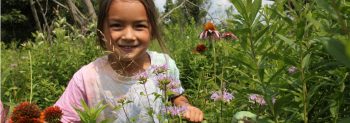
Connecting children to nature initiative builds off Madison city programs
A pack of Sherman Middle School students gathered in a circle at Warner Park to share their constructions of cattails, grass, mud and sticks.
Anke Keuser, a doctoral candidate in the Nelson Institute’s Environment and Resources program at UW-Madison, pulled out boxes of blue, pink and yellow candy Peeps, saying she thought they made a fitting prize for a bird-nest-building competition.
During the school year, the students made weekly excursions to Warner Park as part of a partnership between Sherman Middle School and the Nelson Institute.
The program, begun in 2011, is designed to support park preservation, as well as to fill an important need in after-school programming by building a nature-mentoring relationship between the middle schoolers and a small group of UW-Madison seniors who serve as “co-explorers.”
The program at Warner Park is just one of many in the greater Madison area designed to connect children to nature — there’s a website with a calendar of events at www.naturenet.org.
But the program’s focus on ethnically diverse students, many of whom live in poverty, is a rarity.
That, however, might be changing. In February, Madison was selected as one of seven cities nationally to participate in an initiative to connect urban and minority children to nature.
Created through a partnership between the National League of Cities and the Children & Nature Network, Cities Connecting Children to Nature is focused on getting urban youths to spend more time in green space.
Selected from 43 applicants, each of the seven cities received a $25,000 planning grant, said Margaret Lamar, Children & Nature Network’s director of strategic initiatives.
Research indicates that children’s well-being is directly connected to access to nature, Lamar said.
Children can experience physical and mental health benefits, as well as improved educational outcomes, she said.
Lamar also noted that more time spent in green spaces has been shown to build a better sense of community in neighborhoods.
Ensuring that all children have access to green space is seen as a way to improve the quality of life and boost success among urban youths, she said.[+] Read More
Author: Cadence Bambenek Reblog from Wisconsin State Journal
Photo Credit: Photo by Nature Net




